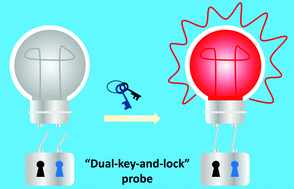Development of “dual-key-and-lock” responsive probes for biosensing and imaging
Abstract
The past few decades have witnessed the rapid development of responsive probes as tools for sensing and imaging of biomarkers in situ in real-time. Among various responsive probes, “dual-key-and-lock” probes have been recently developed as an emerging approach for the detection of biomolecules in specific cell organelles and/or diseased tissues, such as tumours. In comparison with most commonly used “single-key-and-lock” probes, the new “dual-key-and-lock” probes offer substantial advantages in biosensing and imaging, such as high accuracy and precision, minimal “false positive/negative” results, and high selectivity for biomolecule detection at targeted sites. This focus article presents recent advances in the development of “dual-key-and-lock” responsive probes for biosensing and imaging. Two approaches for the design of these probes, including “dual-key-and-one-lock” and “dual-key-and-two-lock”, are highlighted, along with discussions of the challenges and future research directions at the end.

- This article is part of the themed collection: 2020 Focus and Perspective articles


 Please wait while we load your content...
Please wait while we load your content...